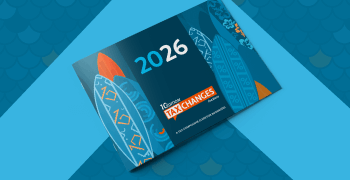
Most trick-or-treaters have no idea how scary candy tax really is – Wacky Tax Wednesday
This post has been updated. It was originally published on October 21, 2015.
Halloween can be a scary time for retailers. They typically need to order inventory months or years in advance, so they can miss out on late-breaking costume crazes. But I think figuring out whether and how to charge sales tax on candy is even more frightening.
Americans are expected to spend more than $11.6 billion on Halloween candy, costumes, and decorations in 2024. We’ll spend $3.5 billion on candy alone. With that kind of sales volume, it’s imperative for retailers to get the sales tax on candy right — and it’s not easy.
Candy containing flour isn’t actually candy
Take the whole, “It’s not candy if it has flour as an ingredient” thing. For sales and use tax purposes, about half of the states define candy as “a preparation of sugar, honey, or other natural or artificial sweeteners in combination with chocolate, fruits, nuts or other ingredients or flavorings in the form of bars, drops, or pieces” — unless it contains flour or requires refrigeration.
Using this definition, Twizzlers and Twix and other tasty candylike treats containing flour are not candy and therefore should not be taxed like candy.
This seemingly arbitrary definition is not without a cause. It was developed by the Streamlined Sales Tax (SST) Governing Board so that the 24 SST member states would have a uniform definition of candy for sales and use tax. Uniform definitions take some of the sting out of sales tax compliance for businesses.
But in this case, they also make for a lot of label reading.
Washington: Now you tax candy, now you don’t
What went down a while back in Washington state ratchets up candy sales tax silliness.
Starting June 1, 2010, lawmakers in my home state decided to tax candy, which had long been exempt as a grocery staple. In preparation for this candy tax, one intrepid Washington Department of Revenue employee began researching the ingredients of every candy product sold in the state, to determine which products contained flour, and which did not. Patrick Gillespie had compiled a single-spaced candy list spanning 87 pages by the time the citizens rose up in revolt and repealed the candy tax with Initiative 1107. Candy has been exempt in Washington since December 2, 2010.
Gillespie volunteered for the job but later confessed, “I didn’t think it would be this big. I mean, look at how many jelly beans there are. It’s just enormous.” The food industry being what it is, there was no end in sight — he had recently been given a list of 11,000 Washington-sold Asian candies. Had Gillespie not been saved by the passage of Initiative 1107, he might still be working on that list.
Taxing our way to better health
The Washington candy tax was more about securing revenue for schools than promoting good health, but across America, health is certainly a concern. Approximately one in five children and adolescents in the U.S. have obesity, according to the U.S. Centers for Disease Control and Prevention. While a good haul of Halloween candy may not tip the scale toward obesity, it probably won’t help solve for it.
Could taxing candy reduce its consumption? Facing high rates of diabetes and obesity, the Navajo Nation figured it was worth a try. In 2014, it enacted the Healthy Diné Nation Act (HDNA), which added a 2% surtax on minimal-to-no-nutritional value foods and also established a sales and use tax exemption for fresh fruits and vegetables.
Although several communities in the United States have a soda tax, the Navajo Nation junk food tax is the first — and to date only — of its kind. Its effectiveness remains to be seen. According to a study published in 2022: 50% of retailers surveyed “strongly agree” that they’d seen increased customer demand for healthier food, but only 30% strongly agree that HDNA had influenced their customers to buy less junk food.
HDNA also created a tax compliance challenge for retailers within the Navajo Nation, per the study. A majority of stores surveyed had added the surtax and provided the exemption, but there wasn’t 100% compliance:
87.2% of Navajo Nation stores accurately applied the 2% sales tax on junk food
55.3% of Navajo Nation stores accurately exempted fresh fruits and vegetables
Six out of 20 stores surveyed reported a “lack of information or confusion regarding what foods are taxable with HDNA tax.” And five out of 20 stores reported a “lack of information or confusion regarding what is tax-exempt with HDNA tax.” Comments by two retailers illustrate some of their pain points.
“We charge junk food [tax] on all of that [soda] because they are processed and have sugar,” reported one retailer. “Now, do we charge the processed drinks like apple juice and orange juice junk food tax or not because in a sense they are produce? …. That was never clarified.”
Another surveyed retailer wrote, “The law is extremely confusing. It’s hard to have a handle on it, if there is no way to figure out what is what. And even when you say these items are at this percent and these are at another percent, then our registers don’t work that way.”
Retailers in other parts of the country have faced similar challenges. After Vermont added an additional tax on soft drinks in 2015, some retailers said compliance was “a nightmare.” And any business selling candy into an SST member state needs to keep the flour and refrigeration rules top of mind.
Sales tax software can make compliance less scary
Sales tax software can help streamline sales tax compliance. If you sell candy or other products into multiple states and you’re tired of reading the fine print of sales tax laws, why not check it out? Maybe sales tax compliance doesn’t have to be so frightening after all.

Avalara Tax Changes 2026 is here
The 10th edition of our annual report engagingly breaks down key policies related to sales tax, tariffs, and VAT.
Stay up to date
Sign up for our free newsletter and stay up to date with the latest tax news.














